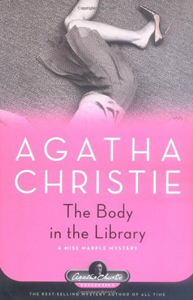Miss Marple goes a surprising 12 years between her first and second novels, returning in “The Body in the Library” (1942). I’m struck by how little Marple appears in the story, although now that I think about it, that was the case with “Murder at the Vicarage,” too.
She trusts no one
Agatha Christie showcases Marple’s laser-focus on what’s relevant, plus her lack of automatic credulity about what any person of interest says.
The St. Mary Mead spinster — who starred in the short-story collection “Tuesday Club Murders” between her first two novels — solves the case without having access to the loads of interviews and discussions that draw in three official investigators, plus Sir Henry Clithering, who is called on to help.

“The Body in the Library” (1942)
Author: Agatha Christie
Series: Miss Marple No. 2
Genre: Mystery
Settings: St. Mary Mead and Devon, England
“The Body in the Library” starts with a sense of humor, which is remarkable considering the grim stuff that will come later. A servant wakes Arthur and Dolly Bantry to inform them there’s a body in their library downstairs.
The couple amusingly wonders if they heard correctly. Later, Dolly gets caught up in the fun of having a mystery occur right under her nose, and revels in the chance to see her friend Miss Marple solve it up-close.
Sense of humor
Christie’s playfulness extends to meta humor. Bodies in libraries happen in books, not in real life, characters say. And we meet a young mystery-novel fan who is thrilled to possess autographs by famous novelists. Among them: Agatha Christie.
As the action shifts to a hotel where the victim worked as a dancer, more broad personalities come from perpetually flustered resident George Bartlett, and angry film-industry worker Basil Blake.
The author gives us a twist on the “gold-digger” scenario. Some believe the victim was using elderly wheelchair-bound Conway Jefferson. Not to marry him for his money, but to be adopted as his daughter for money. It’s one of several of-the-time elements in “Library.”
The rest of this post contains SPOILERS.
Identifying clues (Spoilers)
Christie, as usual, tricked me with the solution. But here I can claim a disadvantage because I’m reading the book 79 years later. The twist depends on someone purposely misidentifying a body as part of a pre-planned frame-job double-murder.
Today, with governmental and other records identifying people in so many ways, this scheme couldn’t happen. But it could in 1942, although I’m betting those were the waning days of the state not being able to identify people without help.
A related peek into the era comes from the position of orphans in society. Because they don’t have family or connections in higher-up society, they apparently aren’t on the books as much. The bad thing about this is they can be used.
Dark revelation (Spoilers)
In an extreme shift from the humor of the early pages, we learn that the pre-meditated double murder involves the use of an orphan – otherwise unrelated to the plot — for the sake of having a second corpse.
Then and now, most murders are committed by someone who knows the victim. As Christie novels illustrate, those common types of murders are more … for lack of a better word … civil. It’s more disturbing to think an innocent person would be selected as a convenient victim for a scheme.
Granted, this dark notion doesn’t permeate the novel’s tone. The reading experience of “The Body in the Library” is not as grim as its subject matter. Still, we are left with a sobering lesson from Miss Marple: Don’t take anyone at their word.


